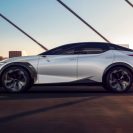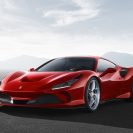The new Ferrari 812 GTS generates 800cv making it the most powerful production convertible on the market. Exactly 50 years on from the debut of the last spider in the Ferrari range to sport a front mounted V12, the 812 GTS hails a triumphant return for a model type that has played a pivotal role in the marque’s history since its foundation.
The Ferrari V12 Spider story features many iconic models that began in 1948 with the 166 MM, an authentic thoroughbred competition GT that won the two most prestigious endurance races in the world in 1949: The Mille Miglia and the 24 Hours of Le Mans. The last in that long lineage was the 1969 365 GTS4, also known as the Daytona Spider because of Ferrari’s legendary victory in the 1967 24 Hours of Daytona when a 330 P3/4, a 330 P4 and a 412 P took the checkered flag side-by-side to occupy the top three places.
The architecture of the front-mounted V12 has not been used in a Ferrari series-production Spider since the 365 GTS4. That said, four special series, limited editions have been launched: the 550 Barchetta Pininfarina in 2000, the Superamerica in 2005, the SA Aperta in 2010 and, most recently, the F60 America of which just 10 were built to celebrate Ferrari’s 60th year on the American market in 2014. There’s more to the 812 GTS than meets the eye; let’s delve into some of its amazing specs and features.
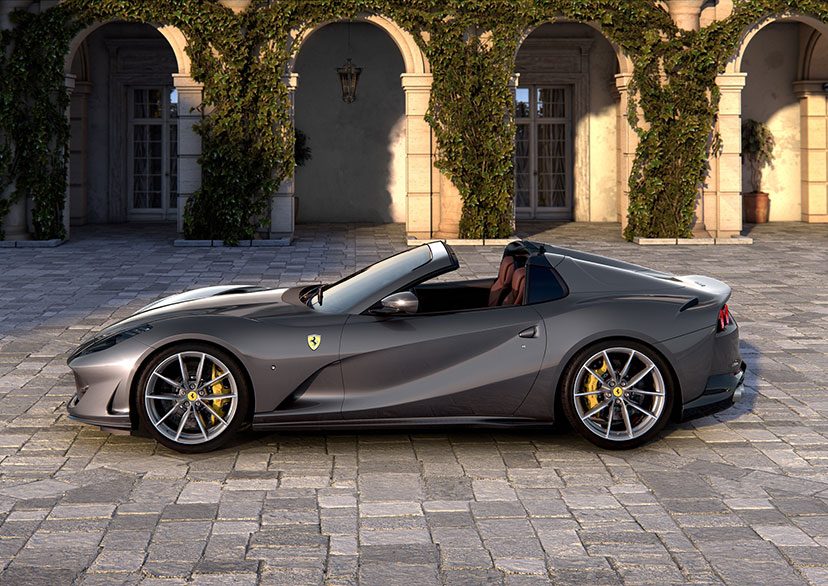
Engine
The 812 GTS is the Spider version of the 812 Superfast, from which it takes both its specifications and performance, most notably the power unit which, thanks to its ability to unleash a massive 800cv at 8500 rpm, it is the most powerful engine in its class. 718 Nm of torque guarantees impressive acceleration, making it virtually on par with the 812 Superfast, while the heady 8900 rpm rev limit means that sporty driving is undiminished.
As with the 812 Superfast, these performance levels were achieved in part, by optimizing the engine design and in part, by innovation. Perhaps this is best exemplified by the use of a 350-bar direct injection system, and the control system for the variable geometry inlet tracts, developed on naturally-aspirated F1 engines. These systems allow for the increase in displacement from 6.2 to 6.5 liters to be exploited to maximize power output whilst retaining excellent pick-up even at low revs.
The high pressure injection system also improves nebulization of the injected fuel, thus dramatically reducing the amount of particulates emitted when the catalytic converter is warming up. As well as the fitment of a Gasoline Particulate Filter (GPF), together with the Stop&Start On the Move strategy, which cuts and restarts the engine while the car is on the move, all of which ensures that the engine complies with all emission regulations.
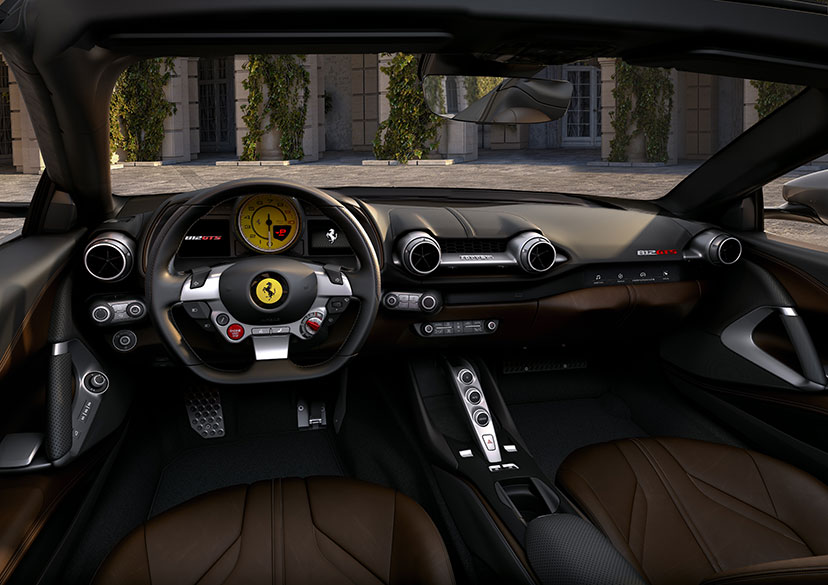
Design
Designed by the Ferrari Styling Centre and based on the 812 Superfast, the 812 GTS reiterates the formal language and proportions of Ferrari’s front-engined V12 without altering either its exterior dimensions or interior space and comfort. In turn, it represents the perfect marriage of sportiness and elegance. From the side view, the 812 GTS has a fastback sleekness: a two-box design with a high tail reminiscent of the glorious 365 GTB4 (Daytona) of 1968.
On the Spider version of the 812 Superfast, the entire rear of the car – roof, tonneau cover and luggage compartment – has been redesigned. The idea was to lend the car a new blend of sleekness and balance, thanks to two buttresses beneath which the roof movement mechanism is stowed. The buttresses were designed to visually embody a sense of forward thrust and lend the side windows a signature look that would set the spider apart from the berlinetta. When the top is dropped, the roof panels disappear beneath the aforementioned tonneau cover.
Aerodynamics
Aerodynamically, the 812 GTS posed two main challenges for the Ferrari designers: How to guarantee the same performance as the coupé version with the top up and, at the same time, ensure maximum passenger comfort with the roof down.
In terms of pure aerodynamic performance, the retractable hard top and its stowage compartment required that the rear of the car be modified. This was achieved, thanks to the meticulous resculpting of the tonneau cover surfaces and, most importantly, the integration of a triplane wing into rear diffuser to create efficient suction and thus downforce. In doing so, the aerodynamicists were able to compensate for the downforce lost by the removal of the 812 Superfast’s rear wheelarch by-pass duct. Drag, on the other hand, was cut by using the air vents on top of the rear flank to efficiently channel excess pressure build-up out of the wheel well.
Vehicle Dynamics
The 812 GTS is equipped with all of the 812 Superfast’s new generation components and control systems and, like it, delivers impressive handling. It sports Electric Power Steering (EPS) which, in line with Ferrari tradition, is used to fully exploit the potential of the car in terms of performance by integrating it with all of the electronic vehicle dynamics controls, including Version 5.0 of Ferrari’s patented SSC.
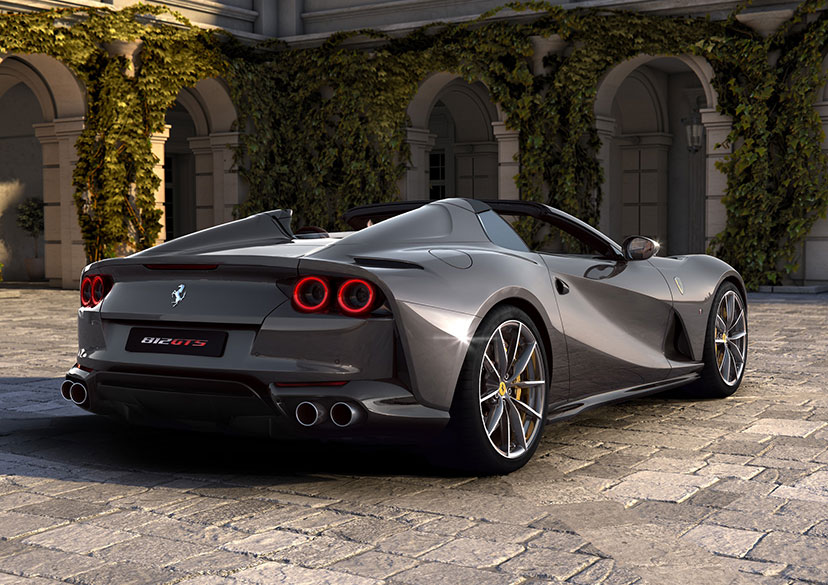
7 Years Maintenance
Ferrari’s unparalleled quality standards and increasing focus on client service underpin the extended seven-year maintenance program offered with the 812 GTS. Available across the entire Ferrari range, the program covers all regular maintenance for the first seven years of the car’s life. This scheduled maintenance is an exclusive service that allows clients the certainty that their car is being kept at peak performance and safety over the years. This very special service is also available to owners buying pre-owned Ferraris.
Regular maintenance (at intervals of either 20,000 km or once a year with no mileage restrictions), original spares and meticulous checks by staff trained directly at the Ferrari Training Centre in Maranello using the most modern diagnostic tools are just some of the advantages of the Genuine Maintenance Program.
For more information, please visit the official Ferrari Showroom in Kuwait- Kuwait Automobile & Trading Co located in Al-Rai, on the 4th Ring Road, visit safat.ferraridealers.com or follow them on Instagram @ferrarialzayanikuwait. Images courtesy of Ferrari Al Zayani.





